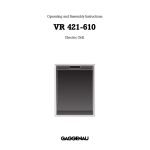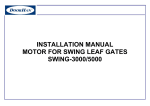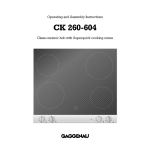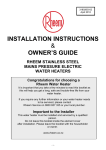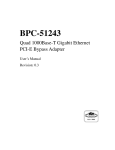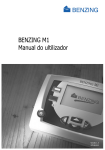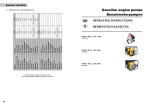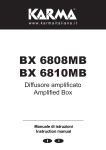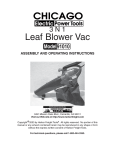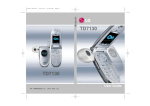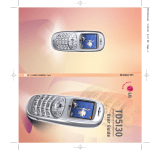Download SOMA INSTALLATION MANUAL
Transcript
SOMA INSTALLATION MANUAL Manufactured by SUNRISE SOLAR 49 VISTA AVE NORTH, COPACABANA NSW 2251 AUSTRALIA PH 61 2 4381 1531 FAX 61 2 4382 1880 EMAIL [email protected] 1 WARRANTY CONDITIONS Sunrise Solar warrants your Soma1000 / Soma400 to be free of defects in materials and workmanship under normal use and service, for a period of one (1) year. This warranty is available from the date of original purchase. All parts will be replaced or repaired free of charge within this period and the unit will be returned at no cost to the owner. Freight charges to the point of purchase and the cost of any repairs resulting from damages occurring during this freighting will be borne by the owner. The provision of this warranty shall not apply if the unit has been subject to misuse, poor installation, neglect, acts of Nature, accidental damage or has been used for a purpose for which it is not designed. The warranty does cover the machine in winds up to 50 metres per second, but does not cover the machine from the effects of flying debris or birds. Any alterations or repairs by unauthorised parties will void your warranty. WARRANTY COUPON Name of Purchaser:........................................................................................ Address of Purchaser:..................................................................................... ..................................................................................................................... Location of Wind Generator (if not at above address):.................................... ..................................................................................................................... Date of Purchase:.................................... Point of Purchase:......................................................................................... .................................................................................................................... 2 INTRODUCTION This manual provides technical descriptions, specifications and installation procedures for the SOMA wind generators. WIND GENERATOR USAGE The SOMA Wind Generator is a battery charging wind generator to supply power for light duty electrical requirements in remote areas. It is designed to be the main source of power to the energy efficient home covering such loads as lighting, radio, television, water pump, washing machine, kitchen blenders, power tools and refrigeration. The maintenance free features of the SOMA 1000 also make it an ideal source of power to telecommunications and scientific equipment located in inaccessable areas. SOMA wind generators have been designed to be used either as a complementary power supply in conjunction with one or more photovoltaic panels; or in particularly windy areas, as a stand-alone power supply system. SIMPLE INSTALLATION It should take two people no more than two days to complete the installation of the SOMA 1000. Recommendations put forward in this manual should be adhered to as closely as possible. An improper site selection or poor installation can seriosly affect the performance of the system. PLEASE READ THIS MANUAL CAREFULLY BEFORE BEGINNING INSTALLATION. 3 LIST OF COMPONENTS Upon recieving your SOMA you will have the following components that must be assembled together. 1. blade 2. tail pipe (strapped to blade) 3. tail fin 4. power head 5. propellor bolts 6. nose cone (SOMA 1000 only) 7. controller THE BLADE The rotor blades are constructed using a hollow moulded fibre glass technique that is inique to Soma. High tensile anilinear glass fibres combined with marine grade resins create a modulus for a blade that is both strong and light. Stainless steel tape provides long term erosion protection for the leading edges of the blades. The blades are in one piece which is pre-balanced and fits into location over the boss of the rotor hub. Four bolts are used to secure the blade to the rotor hub. BLADE CHARACTERISTICS SOMA 1000 SOMA 400 Rotor diamenter Chord length: base tip Pitch at tip Twist Tip speed ratio 2.7 metre 125mm 50mm 2 degrees 7 degrees 10:1 2 metre 125mm 65mm 5 degrees 7 degrees 8:1 ALTERNATOR The SOMA alternator, which is the main component of the power head is a brushless, directly-driven, alternating current generator which utilizes a rotating permanent magnet field. The alternator is designed to produce a power curve that is optimally 4 suited to the two bladed rotor. The copper windings are impregnated with resin to protect them from corrosion. The rotor shaft is stainless steel with sealed ball bearings (bearing number 6205). The rotor hub is galvanised steel. The rotor hub of the alternator contains the powerful permanent magnets which rotate around the 14 pole stator. The alternator produces 3 phase alternating current (AC) which is converted to direct current (DC) by the Soma Controllerr which is located near the batteries. SWIVEL ASSEMBLY The swivel assembly rotates and allows the wind generator to face the wind. It also provides the mechanism by which the rotor can tilt back out of the wind to prevent overspeeding. Housed within the swivel assembly are the brushes and slip rings which carry the power to the cable leading to the batteries. It is made of galvanised steel. The swivel assembly fits over the top of a 65mm NB galvanised pipe tower and is secured with 2 bolts. Sealed ball bearings enable free rotation. (Bearing numbers 6206 and 6007). The tail pipe is secured inside the stator boss and the tail vane is bolted to the pipe. THE SOMA CONTROLLER The controller is located near the batteries which can be located up to 750 metres away from the wind generator depending on system voltage and cable size. The controller is a charge regulator which protects the batteries from being overcharged by the wind generator. It contains a voltage sensing mosfet switching device which switches current across to a dump load when ever battery voltage reaches a pre-set point. The controller also contains the rectifier which converts the 3 phase A.C. voltage generated by the SOMA into D.C. voltage suitable for charging the battery. An amp meter indicates the amount of current that is being produced at any time. FEATHERING MECHANISM The SOMA 1000 utilizes the proven "tilt-up" feathering method to limit 5 rotor speeds in winds in excess of 15ms (metres per second), or 54 kph. It is necessary to limit rotor speed in strong winds to reduce the loads on the wind generator and the tower and to prevent blade wear from overspeeding. The centre of effort of the rotor is above the pivot point of the stator, and wind pressure causes the whole assembly to tilt up. This has the effect of reducing the rotor area presented to the wind, and results in a limitation of the power and rotational speeds achieved by the rotor. The stronger the wind, the further back the rotor tilts. As the wind decreases, gravitational effect pulls the rotor back into normal operating position. A stainless steel hydraulic dampener governs the speed at which the feathering action takes place. This reduces undesirable gyrational action. TOWERS There are two types of tower recommended by Sunrise Solar. The first is a wooden pole which is both an inexpensive and simple solution. The second is a galvinised pipe tower with a built in winch tilt mechanism. WOODEN POLE TOWER In areas where there is an abundant supply, a wooden pole will make the most economic and simple tower. THE POLE The pole should be a minimum of 7 metres long but preferably 10 or 12 metres long. The diameter of the top of the pole should be 175mm. It should be of a type of wood which will not decay in the ground. This can be either a treated soft wood such as tantalised pine or a hardwood known for its ground retention qualities. ALSO NEEDED ARE: 1. 65mmNB Galvinised pipe, medium wall, 2.5 metres long. 2. Two 12mm U bolts 300mm long with 75mm ID and backing plates. 3. Approx. 15 steps made from 16mm reinforcing rod 300mm long. 4. Three guy wire anchors: Can be made by bending 12mm reinforcing rod into U shape to be set in concrete foundation: or, i metre long x 175mm diameter wooden post buried 1 metre under surface: 6 5. 6. 7. 8. or, screw-in type anchors as used for electric power poles. Three turnbuckles or rigging screws strain the rigging tight. Minimum size 10mm. 6mm Wire rope long enough for 3 guy wires. Wire rope grips (6 per guy wire, 18 in total). Concrete for foundation. (rammed earth is another option). The above listed equipment is available from your Soma dealer. POLE PREPARATION Before the pole is raised insert steps and top pipe. Two steps should be placed 150mm below the pole top to serve as a working platform. Below this, steps should be placed at 500mm intervals, alternating from one side of the pole to the other, down to 2 metres above ground level. Two steps should be placed at 1 metre below the top of the pole to act as supports for the guy wires. The pole should have a flat face cut in its side for 1 metre below the top. The top pipe can now be U bolted to this flat face at the top of the tower. It should extend above the tower by 1.5 metres. FOUNDATIONS The hole for the pole should be at least 1.2 metres deep. A trench is dug in to the side of the hole to guide the pole in to the hole as it is being raised. If rammed earth is being used instead of concrete, place a hard wood block at the base of the hole to support the pole. The 3 guy wire anchors should be set in the ground spaced 120 degrees apart. The distance out from the base of the pole should be 60% of the height of the pole. If concrete foundations are used, the holes should be 500mm x 500mm x 500mm. The end loop of the reinforcing rod anchor should protrude 50mm above the concrete. If a wooden post is used, tie the wire rope around the centre of the post before burying it 1 metre below the surface. 7 65mm NB Galvanising Pipe 2.5m long 1.5m Nut U-Bolts 1.0m Backing Plates Nut Side of Pole cut flat Plastic Hose Wire Rope Grips Galvanised Wire Rope 1.0m Steps (Ex 16mm Reinforcing Bar Guy Wire Anchor Rigging Screw Ground Level Concrete (on rammed earth) 1.2m Foundation 600x600x600 8 RAISE THE POLE Secure the three guy wires to the pole. The wire ropes pass around the back of the pole and on top of one of the steps positioned 1 metre below the top of the pole. Use 500mm lengths of black plastic water hose (polypropelene or alkathene) to prevent the wire rope from chaffing on the back of the pole and on the step. Use three wire grips per wire. The pole can be raised by hand, but at least 6 strong people are needed to do so safely. Alternatively, a tractor or heavy vehicle can pull the pole up using a 'gin pole'. Two people with ropes on either side of the gin pole are needed to prevent it from swinging sideways. Raising the pole can be dangerous. Everyone present should have clear instructions and no-one should be at risk should the pole fall. Once the pole is standing in its hole the guy wires can be secured (possibly to temporary anchors) and the pole made level. It is best to view the top pipe from two sides from the ground with a spirit level to ensure it is level. Once vertical, the pole can have the concrete poured in the hole around it, or, alternatively, earth can be rammed into the hole. COMMENT 1. 3. 5. 7. 9. 11. upper pipe gin pole joiner tube lower guy wires wire rope grips foundation rings While is 6 or remove or perform wind generator. For maintenance, a winch-tilt tower as 2. 4. 6. 8. 10. this lower pipe hinge bracket upper guy wires rigging screws shackles type of pole relatively cheap to you have to it to install 6 install, climb 1 annual maintenance on the ease and safety of installation and 5 described next is recommended. 7 7 GALVANISED PIPE WINCH-TILT TOWER 2 8 10 These towers, Solar, 9 4 13m, 11 available come in 4 19.5m and 26m. 3 9 from Sunrise heights: 6.5m, WINCH TOWERS SAFE & EASY features tower tilts down to the ground bi-directional brake winch hot dip galvanised supplied in kit form with or without poles 19.5m TOWER Specifications Height Base Dimensions Outside Foundations Centre Foundation 19.5metres 13.8m x 13.8m 0.7 x 0.7 x 0.7m 1 x 1 x 0.25m deep benefits no climbing no towing safe anti corrosion simplifies installation & maintenance 13m TOWER Specifications Height Base Dimensions Outside Foundations Centre Foundation SUNRISE 10 13 metres 9.2 x 9.2m 0.6 x 0.6 x 0.6m 1 x 1 x 0.25m deep S INSTALLATIO N & Available from FOUNDATION A comprehensive installation manual is provided with each tower kit. Follow these instructions for laying out the footings. For the 19.5m tower, 17m¾ of concrete is required, while for the 13m tower, use at least 1.2m¾. While the concrete is wet, the foundation brackets are placed in position. Allow at least 48 hours for the concrete to strengthen before raising the tower. Raising & lowering the Tower steel guy ropes joiner sleeves gin pole mast poles winch outside centre foundation SHIPPING INFORMATION Tower kits include everything required except for the poles and concrete. Poles can be supplied by Sunrise Solar, but due to shipping costs, these are normally supplied by your local agent. Specifications for the poles are in the tower kit manual. BOX DIMENSIONS 19.5m kit 90kg WEIGHT 700x450x450mm 6.5m & 26m towers also available SUNRISE S ASSEMBLY Lay out the pipes and guy ropes on the ground in position. Feed the cable up through the centre of the mast, then join the mast sections together using the sleeves provided. Bolt the mast and gin pole to the base plate and shackle all the guy ropes to the mast and base loops. Use the rope grips to set the approximate length of the guy ropes. Raise the tower using the winch and set the guy lengths as required. Adjust the turnbuckles to tighten the guys and make the tower vertical and straight. WIND GENERATOR Once the tower has been raised and lowered a few times, attach the wind LAR natural power systems 49 VISTA AVE COPACABANA NSW 2251 PH 043 811531 FAX 043 821880 EMAIL:[email protected] 11 The tower consists of 6.5 metre lengths of galvanised pipe supported by guy wires. Generally 2 lengths of pipe are used to provide a 13 metre tower. However, 6.5 metre towers are high enough in very exposed areas such as on a mountain top while a 26 metre tower may be required if there are a lot of obstacles nearby affecting the wind. The tower requires concrete foundations and it pivots at the base to enable it to be raised and lowered for ease of installation of the wind generator and for maintenance. A jockey pole or gin pole is used for leverage to raise the tower and a winch is secured to one of the guy wire foundations to winch the tower up and down. Tower kitsets are available from your SOMA agent which include all of the components necessary for a 13 metre tower except for the lengths of galvanised pipe and the concrete. The galvanised pipe can also be supplied by Sunrise Solar, but high shipping costs usually mean it is easier and more cost effective for a local steel supplier to supply and pre-drill the poles for you. Drilling details for the poles are supplied in this manual to assist local supply. COMPONENTS FOR 13 METRE TOWER 12 SITE SELECTION The performance of your wind generator depends on four factors: 1) 2) 3) 4) The The The The amount of air turbulence at the site. average wind speeds at the site. distance from the tower to the storage batteries. height of the tower. TURBULENCE The most likely cause of air turbulence is local obstructions such as trees, buildings and hills. When a smooth airstream encounters a nearby obstruction, it is broken up into gusts of variable strength and direction. As these gusts hit the wind generator it will be continually accelerating, decelerating and turning, causing variations in the stresses on different parts of the blade, shafts, bearings and tower. To avoid these destructive effects, it is essential to erect the wind generator at least 5-10 metres above any obstruction that is within a radius of 100 metres. AVERAGE WINDSPEEDS The average windspeed will determine the amount of power the wind generator supplies to the battery bank. The power available in the wind depends on one very important characteristic. POWER GOES UP BY THE CUBE OF THE WIND SPEED. This means that a 10 m/s wind has 8 times more power than a 5 m/s wind. Or a site with an average winspeed of 6 m/s has 73% more power than a marginal 5 m/s site. IT IS ESSENTIAL TO SELECT A SITE WITH AS MUCH WIND AS POSSIBLE. SOMA wind generators have been designed to extract as much power as possible from light and moderate windspeeds. However, it is generally accepted that where the average annual windspeed is under 4 to 5 metres per second, harnessing the power is not viable. HEIGHT The wind speed nearly always increases with height. The amount that 13 the wind increases above the ground depends on the surface roughness, whether grass plains, tall crops and hedges, or bush, forest and woodlands. The windspeed at 10 metres above head high scrub and bushes would be at least 1.5 times the wind speed at 3 metres above the scrub. Considering the cubic relationship between windspeed and wind power, the power at 10 metres is 3.5 times the power at 3 metres. Considerable gains in energy output can be obtained from a wind generator by siting it in the best possible location. Often the extra costs involved, such as the price of an extra tall tower or the cost of extra copper cable to reach a nearby hilltop are more than compensated for by the increased output. DISTANCE TO BATTERIES Consideration must be given to the length of cable running from the wind generator to the batteries. At higher amperages in higher windspeeds there will be more losses due to the resistence of the copper wire. The factors affecting these losses are: 1. length of transmission line 2. size of wire used 3. amperage output of wind generator The greater the distamce to the batteries the larger the size of copper cable. The following table should serve as a guide in selecting cable size for a given transmission line length. Cable length from Batteries Minimum Wire Size to the Wind Generator 3 core copper S400 12Volt 50 metres 100 metres 200 metres 300 metres 500 metres 750 metres S400 24V 6mm 6mm 10mm ---- S1000 24V 4mm 6mm 6mm ---- S400/S1000 48Volt 16mm 25mm ----- 14 6mm 10mm 16mm ---- S400/S1000 110Volt 2.5mm 2.5mm 4mm 6mm 10mm 16mm It is usually better to select a site that is further away, if that site has more wind. The copper losses are very minimal at low to medium power output levels and the increased outputs in higher winds will usually outweigh the losses. It is often advisable to install a 110 volt wind generator and then use a transformer beside the batteries to reduce voltage to the required battery volts. This will enable optimum siting of the wind generator while reducing the cost of the cable. Soma transformers are available from Sunrise Solar. INSTALL THE WIND GENERATOR The SOMA 1000 wind generator is transported to you in 7 seperate pieces as previously detailed. INSTALLATION PROCEDURE The installation procedure is as follows. The instructions assume that a wooden pole type tower is used. However, if a galvanised pipe tower is used the instructions would be the same except the procedure would be carried out on the ground before the tower was raised. Two people are needed to install the wind generator on top of the tower. The 'top person' and the 'ground person'. THE TOP PERSON MUST WEAR A SAFETY HARNESS. THE GROUND PERSON MUST WEAR A HARD HAT. The top person will also need: a rope to lift the wind generator parts up; leather gloves; two 10" adjustable spanners; a screwdriver suitable for attaching the nose cone. 1. Fasten electrical cable. (wooden pole tower only) The Soma 1000 is supplied with connector strip terminations extending 75mm below the swivel assembly. To simplify the installation of the alternator and swivel on the tower top, it is beneficial to add 2.5 metres of cable. The cable will then be long enough to extend by 150mm below the galv pipe at the top of the tower when the machine is installed. The connection to the 15 cable running to the batteries can then be made at the base of the 2.5 metre length of galv pipe. 1a. Fasten electrical cable. (galv pipe tower) The same electrical cable that runs from the tower to the batteries is fed up the inside of the galv pipe tower to the top. (It may be neccessary to use a lighter feeder wire to pull the cable through with). Tie a loop in the cable 75mm from the end so that when the wind generator is in place on top of the tower, a 10mm bolt can pass through the tower and loop. This will support the weight of the cable so that strain is not placed on the terminals of the wind generator. Connect the cable to the connector strip terminals that protude 75mm out of the swivel assembly. Place the swivel assembly and alternator over the top of the tower and fasten the 2 locking bolts. 2. Raise the alternator/yaw assembly The top person should climb the tower and secure himself to the pipe at the top of the tower with the harness. The alternator/yaw assembly weighs 30kg. The top person must be strong enough to raise this weight to the tower top. He should have a strong soft rope and leather gloves. (It is possible to rig up a pulley block attached to the top of the pipe to enable the ground person to lift the alternator/yaw assembly if required). The 2.5 metres of cable is fed down the inside of the galv pipe and the alternator/yaw assembly is placed over the top of the pipe. The 2 locking bolts should be tightened. 3. Make the electrical connection at the base of the 2.5 metre length of galv pipe to the cable which runs down the wooden pole 16 SOMA WIRING Dump resistors The SOMA CONTROLLER is comprised internally of the rectifier and the regulator. WIND GEN. AMPS SOMA CONTROLLER VOLTAGE ADJUST 1 L.E.D. 2 3 4 5 6 BRAKE SWITCH MINIMUM FUSE AMPS FROM SOMA WIND GENERATOR FUSES BAT- SOMA SOMA 12 63A - 24 32A 63A 48 16A 32A 110 8A 16A - + BATTERY IMPORTANT The rectifier and regulator must be seperately fused to the battery. This protects the regulator from the high open circuit voltage of the wind generator in the event of the rectifier fuse failing or being accidently removed during operation. The rectifier fuse should be labelled “DO NOT REMOVE BEFORE WIND GENERATOR BRAKE IS APPLIED”. 17 and all the way to the control panel. Push the connection up inside the galv pipe and fasten the cable to the wooden pole. 4. Bolt the tail vane to the tail pipe using the 6mm bolts provided. Use LOCTITE on the nuts. This can be done at ground level. 5. Raise the tail pipe/tail vane assembly. The tail pipe should be inserted into the back of the alternator. The securing bolt should be tightened so that the housing clamps tightly around the tail pipe. The housing is split to allow the clamping action to work. Once tightened, there should be no movement of the tail pipe inside the housing at all. A possible consequence of movement is wear of the 10mm bolt. USE LOCTITE on the nut. 6. Bolt the blade to the alternator. Use 4 stainless steel 10mm x 45mm bolts with the washers provided. USE LOCTITE. 7. Fasten the nose cone (SOMA1000 only). There are 4 screws provided to fasten the nose cone to the blade. USE LOCTITE. The wind generator is now ready for operation. But, before allowing it to turn, the control panel must be installed. To prevent turning, tie the blade with a piece of rope. INSTALL THE CONTROLLER A detailed description of the operation of the regulator inside the controller follows later in this manual. IMPORTANT: READ THIS SECTION COMPLETELY BEFORE PROCEDING. It should be located in an accessible, dry location within 5 metres 18 of the battery bank. The dump resistors on top will get hot to the touch and should be located at least 0.5 metres below any horizontal surface such as a ceiling or cabinet top. It should not be fastened to an inflamable surface such as wood. (Use fire proof board between them and an inflamable wall). MAKING THE CONNECTIONS It is very important that the wind generator is not allowed to spin before the wiring is complete, otherwise it will have no load and could overspeed. Before you begin, turn the battery voltage adjusting knob on the controller to the highest setting (fully clockwise). Wiring can then be completed, with the fuses (or circuit breakers) being installed last. See wiring drawing on following page for detailed wiring instructions. The wire from the controller to the batteries should be flexible and should be colour coded RED (positive) and BLACK (negative) to avoid confusion in hooking the wire to the battery bank. DO NOT REVERSE THE POLARITY - THE ELECTRONICS WILL BE DAMAGED!!! The recommended wire size for installations where the controller is less than 5 metres from the batteries is 16mm. Longer distances than this will require larger wire size. The wind generator is now ready for operation. But, before you allow it to start generating, please read the remainder of this manual to familiarise yourself with the operation of the controller and other aspects of the system. REGULATOR FUNCTION AND OPERATION The purpose of the regulator is to prevent the wind generator from overcharging the battery. As a battery is charged it absorbs electric power. Provided that the battery is correctly sized and is in good condition it will absorb power at a high rate (50amps at 24 volts, for example). When the battery is approaching full and the voltage has risen (29 to 30 volts 19 Note: If your system contains solar power as well, it is best to set the Soma regulator at the equalization voltage so that the Soma regulator does not override the settings on the Solar regulator. ELECTRICAL BRAKE It is possible to stop the wind generator from turning in the wind by placing a short circuit across the alternator output. This should only be done in light wind speeds to stop the wind generator for servicing, etc. The electrical brake will not stop the wind generator in very strong winds. Any attempt tostop it with the electrical brake in strong winds may result in burning out the alternator windings. If the wind generator has not slowed to less than 20 RPM in less than 1 minute of applying the brake, then it is too windy to attempt to stop the machine and the brake must be released. An electrical brake can be factory fitted as an optional extra. Once the wind generator has stopped the brake will prevent it from starting again even in strong winds. COMMISSIONING THE WIND GENERATOR When the wiring has been completed, the wind generator can be commissioned. With the electrical brake on, winch up the tower and wind generator into its working position. When the tower is secured in its upright position, release the electrical brake. If there is enough wind the rotor should start spinning and amperage should be registering on the amp meter. UNDER NO CIRCUMSTANCES SHOULD THE WIND GENERATOR BE ALLOWED TO OPERATE WHILE DISCONNECTED FROM THE RECTIFIER & BATTERIES. The rotor should spin freely and should not shake or vibrate. If any abnormalities are observed, the brake should be re-applied and the unit lowered so that the problem can be analyzed and fixed. Under normal circumstances, the SOMA Wind Generator can now be left unattended to generate power. When the batteries are fully charged, the regulator will divert current to the dump load. 20 MAINTENANCE The SOMA Wing Generator has been designed to be very rugged and durable. As such, the maintenance required is minimal. Along with several visual checks, the only maintenance required is to grease the tilt back bushing and the hydraulic dampener bolts once a year. MAINTENANCE PROCEDURE 1. Engage electrical brake on a light wind day and lower tower 2. Physically inspect all bolts on the tower and wind generator to ensure that they are secure. 3. Check that wind generator turns freely and tilts back freely. 4. Check that the blade is in good condition and that it has not been hit or damaged by flying objects. 5. Grease the tilt back mechanism through the two grease holes. 6. Grease the hydraulic dampener bolts. 7. The hydraulic dampener should be topped up with 20/30 engine oil if it has lost oil. Be sure that it is not overfilled. The dampener may need to be removed from the machine to do this, as the dampener needs to be filled while in a vertical position. This depends on whether your tower tilts down horizontally. Fill through the top bushing screw hole and fully depress the plunger after filling to squeeze out the excess. Allow the plunger to return to its normal position, then replace the screw. Use loctite on the mounting bolts when replacing the dampener. 8. Observe operation of wind generator. 9. Ensure that the guy wires and rigging screws are securely tightened. DOS AND DON'TS Please observe the following rules for the operation of your wind generator. They are very important and to disregard them may result in the failure of the wind generator. 1. DO ensure that the site you have selected is free from obstacles that cause turbulent air. 2. DO use copper cable of sufficient diameter for the distance to the batteries. 3. DO ensure that the controller is situated close to the batteries and is in a dry place. 4. DO NOT allow the wind generator to operate while the controller is disconnected from the batteries. 5. DO NOT climb or lower tower without engaging the electric brake. 6. DO NOT allow the wind generator to operate while it is disconnected from the controller. 7. DO grease the tilt back bushing once a year. 8. DO NOT use old or undersized 21 batteries.





















